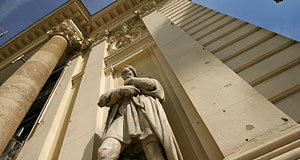Künstlerhaus Wien - Artists′ House Vienna

The Künstlerhaus Wien is a gallery that provides exhibition space for local artists and is located by the Ringstraße by Karlsplatz Square just next to the Musikverein building with its famous concert hall. It is dedicated to paintings, sculpture, architecture and applied arts and design.
It was built between 1865 and 1868 for the "Gesellschaft bildender Künstler Österreichs", the oldest Austrian association of artists. The architect in charge with designing the not particularly exciting building was August Weber. The Künstlerhaus wouldn′t play any particularly distinguished role in the vast number of art museums and galleries in Vienna, but it was this gallery and the artist association behind it that the "Secession" artists split from in 1897.
At this time, the Gesellschaft bildender Künstler Österreichs was considered to be conservative in its approach to art - historicism was a big deal with Austria′s establishment in the late 19th century, and there was little innovation to expect from the Künstlerhaus.
Where the Secession split from
It had been opened officially on the 1st of September 1868, which means that it is among the oldest Ringstraßenbuildings. Soon after the opening, it became obvious that the building would need an extension. At this time, the Wien River did now run through a covered underground canal as it does now, but as an open creek. Along the banks of the creek, the Künstlerhaus grew to side wings, opened in 1882.
When these were filled up, too, the inner courtyard was covered in 1888. The site around the building developed rapidly, too - the Wien River was covered up and thereby, a large square (the Karlsplatz) became accessible for traffic. By the 1930ies, the area was so densely populated and expensive, that there were plans to either add more floors or demolish and rebuild the Künstlerhaus bigger than it was.
WWII & the Current Künstlerhaus
It was probably WWII that delayed the development, but after the war, the ideas of developing the site was picked up again. IBM wanted to erect a major office building instead of the Künstlerhaus in 1966, and until then, there had been several other project proposed. In the 1960ies, the general awareness of the value of "old buildings" and their social appreciation grew (partly because of the ruthless concrete development of this decade).
So once the IBM plan was abandoned, no such ideas were proposed anymore. Since 1947, there is a cinema inside the Künstlerhaus, which is probably the most modern addition to the building and re-furbished and extended to a theatre in the 1970ies. As an art venue, the Künstlerhaus plays a rather minor role, but there are plans to involve it more intensively into the MuseumsQuartier cluster of museums in the future.
Other nearby attractions include a whole bunch of other art museums: The Secession (its old rival, to the opposite on the other side of the Karlsplatz), the Academy of Fine Arts, the Kunsthistorisches Museum with its various branches, the Karlskirche Church, and - with some walking involved - the Belvedere Castle and Museum. The Staatsoper, the Hofburg, the Wien Museum is nearby, and the Naschmarkt Market with Otto Wagner Jugendstil buildings.
back to "vienna
travel guide"
Vienna by District
District Overview - 1st (Innere Stadt) - 2nd (Leopoldstadt) - 3rd (Landstraße) - 4th (Wieden) - 5th (Margareten)- 6th (Mariahilf) - 7th (Neubau) - 8th (Josefstadt) - 9th (Alsergrund) - 10th (Favoriten) - 11th (Simmering) - 12th (Meidling) - 13th (Hietzing) - 14th (Penzing) - 15th (Fünfhaus) - 16th (Ottakring) - 17th (Hernals) - 18th (Währing) - 19th (Döbling) - 20th (Brigittenau) - 21st (Floridsdorf) - 22nd (Donaustadt) - 23rd (Liesing) - Ringstraße - Surroundings
Further Reading
Official Website of the Küstlerhaus Gallery
German Wikipedia entry on the Künstlerhaus
Official website of the Vienna Tourist Information
